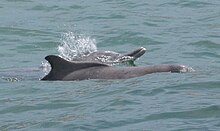
Back Boggelrugdolfyn Afrikaans دلافين سنامية Arabic الدلفين السنامى ARZ Yaburol (Sousa) AVK Sousa (gènere) Catalan Sousa CEB Sousa (Gattung) German Ĝibodelfenoj Esperanto Sousa (género) Spanish Sousa Basque
| Humpback dolphin | |
|---|---|

| |
| Humpback dolphins surfacing for air | |

| |
| Size compared to an average human | |
| Scientific classification | |
| Domain: | Eukaryota |
| Kingdom: | Animalia |
| Phylum: | Chordata |
| Class: | Mammalia |
| Order: | Artiodactyla |
| Infraorder: | Cetacea |
| Family: | Delphinidae |
| Subfamily: | Delphininae |
| Genus: | Sousa Gray, 1866 |
| Type species | |
| Steno lentiginosus [1] Gray, 1866
| |
| Species | |
| |

| |
| Range of each species | |
Humpback dolphins are members of the genus Sousa. These dolphins are characterized by the conspicuous humps and elongated dorsal fins found on the backs of adults of the species. Humpback dolphins inhabit shallow nearshore waters along coastlines across Australia, Africa, and Asia. Their preference for these habitats exposes them to various human activities such as fisheries entanglement, boat traffic, pollution, and habitat loss. Despite these risks, their nearshore presence facilitates easy observation from land.
There are four recognized species: the Indo-Pacific humpback dolphin (Sousa chinensis), Indian Ocean humpback dolphin (S. plumbea), Atlantic humpback dolphin (S. teuszii), and Australian humpback dolphin (S. sahulensis).
Although generally shy and less active compared to bottlenose dolphins, they are occasionally featured in dolphin watching tours, particularly in locations like Hong Kong and the Musandam Peninsula of Oman.
- ^ Wilson, D. E.; Reeder, D. M., eds. (2005). Mammal Species of the World: A Taxonomic and Geographic Reference (3rd ed.). Johns Hopkins University Press. ISBN 978-0-8018-8221-0. OCLC 62265494.
© MMXXIII Rich X Search. We shall prevail. All rights reserved. Rich X Search